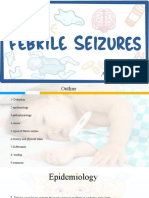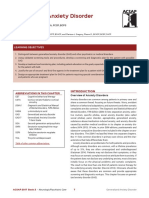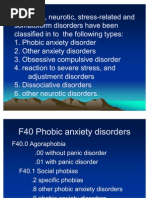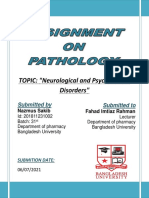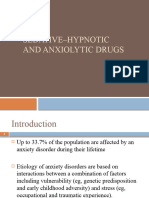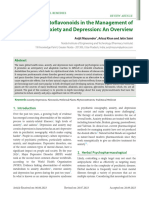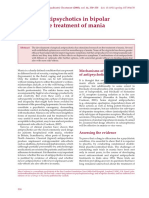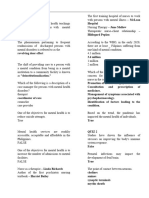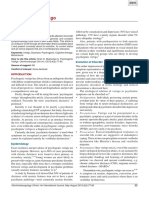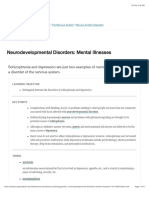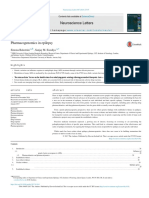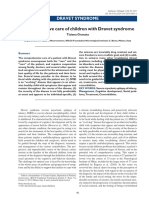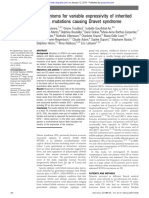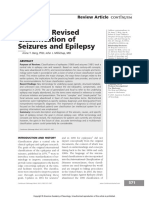Professional Documents
Culture Documents
Anxiety and Epilepsy: Current Understanding and Future Perspectives
Anxiety and Epilepsy: Current Understanding and Future Perspectives
Original Title
Copyright
Available Formats
Share this document
Did you find this document useful?
Is this content inappropriate?
Report this DocumentCopyright:
Available Formats
Anxiety and Epilepsy: Current Understanding and Future Perspectives
Anxiety and Epilepsy: Current Understanding and Future Perspectives
Copyright:
Available Formats
Volume 9, Issue 4, April – 2024 International Journal of Innovative Science and Research Technology
ISSN No:-2456-2165 https://doi.org/10.38124/ijisrt/IJISRT24APR503
Anxiety and Epilepsy: Current Understanding and
Future Perspectives
N.V.L. Suvarchala Reddy1; M. Ganga Raju2; D. Pushyami Sudha3; P. Shrivani4; P. Anusha5
Department of Pharmacology, Gokaraju Rangaraju College of Pharmacy, Hyderabad (500090) India
Abstract:- Anxiety is characterized as an overwhelming anxiety due to inherited or acquired factors, such as stress.
sense of worry or fear for the future, while epilepsy is a These disorders include five main types of generalized
chronic neurological condition. Both anxiety and anxiety disorder, obsessive-compulsive disorder, panic
epilepsy are prevalent conditions that impact individuals disorder, posttraumatic stress disorder (PTSD), social
globally and are associated with diminished function and phobia, and social anxiety disorders [1]. For at least six
life quality. This review article explains about the months, at least three of the following symptoms have been
treatment, etiology, pathophysiology, current advances linked to anxiety: restlessness, which includes irritability,
and neurological relationship between anxiety and tense or agitated sensations, weariness fast, problems
epilepsy. Previous research suggests that anxiety concentrating or losing your mind, impatience, tense
disorders are widespread and clinically relevant muscles, and disturbed sleep [4].
comorbid diseases in epilepsy patients because anxiety
can cause seizures or seizures may cause anxiety. To treat II. TREATMENT
anxiety and epilepsy, a thorough, multidisciplinary
clinical assessment is required. Medication, lifestyle Monoamine reuptake inhibition is currently the most
modifications, and psychotherapy are also required. effective treatment for moderate to mild chronic anxiety [5].
Selective serotonin reuptake inhibitors (SSRIs), the most
Keywords:- Anxiety, Current Advances, Epilepsy, GABA commonly prescribed family of antidepressants, are the
(Gamma Amino Butyric Acid), Treatment, Pathophysiology. first-line therapies for anxiety disorders; tricyclic
antidepressants, buspirone, and pregabalin are also helpful
I. INTRODUCTION [6]. Benzodiazepines are also frequently used to treat acute
anxiety, even though they are useful for the majority of
Anxiety is a state that leads to a heightened sense of patients. Benzodiazepines do, however, appear to be linked
threat and a response to it that might include a variety of to chemical, physical, and mental dependence. The degree
defensive behaviors [1]. When uncertain danger is of anxiety disorders determines how effective a treatment
imminent, anxiety is a physiological state of distress and plan will be; therefore, it is critical to develop novel
restlessness [2]. Anxiety is thought to affect 4.05% of global therapeutic strategies to lessen the negative effects of
population [3]. These are the mental health issues that are anxiety on society and the economic market [7][8][9][10]
most common. Pathological anxiety disorders are caused by
abnormalities in neural circuits involved in mood and Recent Advances
Table 1 Recently Marketed Drugs for Anxiety
S.no Drug Treatment Refs.
1 Agomelatine Generalized anxiety disorder 11,12
2 Escitalopram Generalized anxiety disorder 11,12
3 Vilazodone Generalized anxiety disorder and social anxiety disorder 13
4 Gepirone Anxiety 14, 15
5 Tandospirone Generalized anxiety disorder 16
6 Psilocybin Anxiolytic better in combination with psychotherapy 17, 18
Table 2 Novel Drugs in Clinical Phase [19]
S.no Drug Phase Indication
1 MM – 120 2 General Anxiety Disorder
2 AVN – 101 2 General Anxiety Disorder
3 ACH 000029 1 General Anxiety Disorder
4 Darigabat 1 Panic Disorder
5 Aloradine 3 Social Anxiety Disorder
6 Cannabidiol 3 General Anxiety Disorder
7 RLS103 1b/2a Social Anxiety Disorder
8 BNC210 2 Social Anxiety Disorder
9 VQW-765 2 Performance anxiety
IJISRT24APR503 www.ijisrt.com 344
Volume 9, Issue 4, April – 2024 International Journal of Innovative Science and Research Technology
ISSN No:-2456-2165 https://doi.org/10.38124/ijisrt/IJISRT24APR503
Etiology
Many biopsychosocial factors seem to contribute to
anxiety disorders. Clinically important illnesses arise from
the interaction of genetic vulnerability and stressful or
traumatic circumstances. Few of the reason anxiety might be
caused are as follows
Prescription medications
Substance abuse
Alcoholism
Trauma
Early life events
Stress
Illnesses like diabetes and epilepsy
Other comorbidities like depression can all make anxiety
worse [20]
III. PATHOPHYSIOLOGY
In the central nervous system, dopamine, serotonin,
Fig 2 Pathophysiology of Anxiety [23]
norepinephrine, and gamma-aminobutyric acid (GABA) are
the primary neurotransmitters that cause anxiety. Most
Introduction
symptoms are mediated by the autonomic nervous system,
Epilepsy, a chronic neurological illness, are seizures,
particularly the sympathetic nervous system. The amygdala
which are recurrent paroxysmal clinical events. These
plays a crucial role in managing anxiety and fright. It has
seizures are brought on by an abnormal and
been discovered that the amygdala responds more strongly
hypersynchronous discharge of a group of brain neurons
to alarming stimuli in patients with anxiety disorders.
[24]. According to a World Health Organization research,
Pharmaceutical or psychological interventions can be used
epilepsy contributes almost seven million years of disability-
to correct anomalies in prefrontal-limbic activation since the
adjusted life years to the worldwide sickness burden,
prefrontal cortex is related to the limbic system and the
making it a major cause of impairment [25]. Among the
amygdala (20).
most common symptoms of epilepsy patients are staring,
jerking, uncontrollably jerky movements, sudden falls,
Because the amygdala projects to the hypothalamus,
perplexity, aura, strange feelings and sensations, loss of
which in turn controls the autonomic nerve system, it affects
consciousness, and concern [26].
blood pressure, heart rate, and changes connected to stress.
Treatment
The brain's medial temporal lobe contains the
Topiramate, lamotrigine, and valproic acid are the first-
hippocampus, which regulates emotional actions, especially
line medications for atonic, atypical myoclonic, and primary
those related to anxiety, in addition to cognitive processes
generalized tonic clonic seizures. These include valproic
[6]. The diverse ways in which the hippocampus's dorso-
acid, oxcarbazepine, carbamazepine, and phenytoin for
ventral axis regulates anxiety and cognitive functions help to
partial seizures. These include ethosuximide and valproic
explain these unique roles [21]. There is mounting evidence
acid for absence seizures [27].
that the ventral hippocampus plays a major role in the
processing of anxiety. Higher levels of anxiety and higher
Numerous studies and research findings indicate that
levels of hippocampus activity have been linked in previous
the combination of medications aids in the management of
research [6].
the illness. It has been observed that patients respond to the
same medications at various dosages in different ways. This
may indeed be the case, since several pathophysiological
pathways can present in an individual at any given time. To
have better results in this situation, varying therapy
modalities would need to be used to varying degrees. The
combination of lamotrigine and sodium valproate has been
shown in numerous animal models to be effective in treating
both partial-onset and generalized seizures. To treat a variety
of seizures, lamotrigine and topiramate are another
combination that is typically advised, as is valproate and
ethosuximide to manage absence seizures[28].
Fig 1 Pictorial Representation of the Parts of Brain that
Influences the Anxiety [22]
IJISRT24APR503 www.ijisrt.com 345
Volume 9, Issue 4, April – 2024 International Journal of Innovative Science and Research Technology
ISSN No:-2456-2165 https://doi.org/10.38124/ijisrt/IJISRT24APR503
Recent Advances
Table 3 Recently Marketed Drugs for Epilepsy
S.no Drug Treatment Refs.
1 Vigabatrin Infantile spasms and refractory complex partial seizures 29
2 Fenfluramine Dravet syndrome and LGS 30
3 Cenobamate Adult partial onset epilepsy 30
4 Cannabidiol Dravet syndrome 31
5 Valium and nasal midazolam Rescue therapy 30
Table 4 Novel Drugs in Clinical Trials [32]
S.no Drug Phase Population
1 XEN1101 3 Focal and generalized epilepsy
2 BHV-7000 1 Drug-refractory focal and generalized epilepsy
3 ETX-123 Preclinical Drug-refractory focal and generalized epilepsy
4 NBI-921352 2 Focal-onset seizures
5 Lacosamide 2/3 Neonates
6 OV329 1 Rare adult and pediatric epilepsies
7 Alprazolam 3 Long or clustering seizures
8 Ganaxolone 4 CDKL5 deficiency disorder (approved), TSC, LGS, refractory Status epilectus
9 NRTX-1001 ½ Unilateral drug-refractory mesial temporal lobe epilepsy
10 Brivaracetam 2/3 Absence epilepsy
11 Radiprodil 2b Pediatric patients with gain-of-function GRIN variants: seizure cohort, behavioral cohort
12 LP352 1b/2ia DEEs
13 SPN-817 1ia Adult patients with refractory focal impaired awareness epilepsy
Abbrevations:
TSC- tuberous sclerosis complex, LGS- Lennox–Gastaut syndrome, DEE- developmental and epileptic encephalopathy
Table 5 Novel Devices for Epilepsy [32]
S.no Device Phase Population
1 EASEE 2 Drug-refractory epilepsy
2 Tdcs 3 Drug-refractory epilepsy
3 EmbarcePlus FDA approved Seizure detection
4 EpiCare@Home CE mark approved Seizure detection
5 REMI Ongoing Seizure detection
6 Epihunter CE mark approved Absence seizures
Abbrevations: Disturbances in electrolytes (hypo/hyper calcemia,
EASEE- Epicranial Application of Stimulation hypo/hyper natremia)
Electrodes for Epilepsy; REMI, Remote EEG Ambulatory Adverse reactions to medications
Monitoring; tDCS, transcranial direct current stimulation. CNS infections
Traumatic head injury
Etiology Hypoxic brain injury
There is a chance for both prompted an unprovoked Ischemic or hemorrhagic stroke
seizures. Acute symptomatic seizures, also referred to as Sleep deprivation
provoked seizures, can be caused by a variety of diseases. Genetics [33]
These ailments include tumors or other mass lesions, brain
trauma, viral infections, poisonings, and vascular anomalies.
Seizures can be brought on by a variety of factors, including
problems with nearly any medical condition. The following
is a list of some typical causes:
IJISRT24APR503 www.ijisrt.com 346
Volume 9, Issue 4, April – 2024 International Journal of Innovative Science and Research Technology
ISSN No:-2456-2165 https://doi.org/10.38124/ijisrt/IJISRT24APR503
Pathophysiology
Fig 3 Flowchart of the Pathophysiology of Epilepsy [34]
Fig 3 Pathophysiology of Epilepsy [35]
IJISRT24APR503 www.ijisrt.com 347
Volume 9, Issue 4, April – 2024 International Journal of Innovative Science and Research Technology
ISSN No:-2456-2165 https://doi.org/10.38124/ijisrt/IJISRT24APR503
IV. RELATIONSHIP BETWEEN REFERENCES
ANXIETY AND EPILEPSY
[1]. Craske, M.G., Stein, M.B. Anxiety, The Lancent, vol
GABA is predominantly associated with the 388(10063), 2016, pp. 3048-3059.
neurochemical aspect of the neurobiological hypothesis [2]. Magalhães, L.S. Anxiolytic-like action of 3-((4
because it is an inhibitory neurotransmitter. GABAergic methoxyphenyl) selanyl)-2-phenylbenzofuran
inhibition failure in the central nervous system is frequently (SeBZF3) in mice: A possible contribution of the
linked to anxiety disorders. For instance, patients with panic serotonergic system, pharmacology biochemistry and
disorder exhibit decreased flumazenil binding to behavior, vol 232, 2023.
benzodiazepine receptors in certain brain areas, indicating [3]. Javaid, S.F., Hashim, I.J., Hashim, M.J., Stip,
down-regulation of these receptors. Interestingly, studies E., Samad, M.A., & Ahbabi, A.A. Epidemiology of
have shown that individuals with hippocampal sclerosis anxiety disorders: global burden and
have similar reductions in flumazenil binding to sociodemographic associations. Middle East Curr
benzodiazepine receptors in their temporal lobes. For those Psychiatry, vol 30, no 44, 2023.
who have epilepsy, this recurrent metabolic imbalance may [4]. Munir, S., Takov, V. Generalized anxiety disorder, In:
be a source of anxiety [36]. Epileptics frequently experience StatPearls [Internet]. Treasure Island (FL): StatPearls
anxiety, particularly those who have temporal lobe epilepsy, Publishing, 2022.
which results in hyperexcitability in the hippocampus which [5]. Patriota, L.L.S., Lima, B.R.F., Marinho, A.O., Costa,
is also responsible for the anxiety [37]. J.A., Coelho,L.C.B.B., Paiva,P.M.G., Rosa, M.M., T
H Na. The anxiolytic like activity of water soluble
Preictal anxiety symptoms might manifest hours or Moringa Oleifera Lam. Lectin is mediated via
days before a seizure. The phrase "ictal panic" describes serotoninergic, noradrenergic, and dopaminergic
anxiety symptoms that manifest during the ictal interval, neurotransmission, brain disorders, vol 9, 2023,
which might be difficult to distinguish from a classic panic 100066.
attack. Ictal panic or fear is the most prevalent type of [6]. Ghasemi, M., Navidhamidi, M., Rezaei, F., Azizikia,
simple partial seizures, accounting for 60% of all psychiatric A., & Mehranfard, N. Anxiety and hippocampal
auras and usually presenting as mental symptoms. Anxiety is neuroactivity: relationship and potential mechanisms,
the most prevalent emotional symptom in the 72 hours that cognitive, affective and behavioral neuroscience, vol
follow a seizure or cluster of seizures. These often occur six 22, 2022, pp. 431-449.
to twenty-four hours following the onset of the seizure. It is [7]. Bandelow, B., Michaelis, S., & Wedekind, D.
common for postictal anxiety to coexist with other Treatment of anxiety disorders. Dialogues Clin
dysphoric symptoms, such as depression. Anxiety, panic Neurosci, vol 19(2), 2017, pp. 93-107.
episodes, agoraphobia, and compulsive symptoms are [8]. Breilmann, J., Girlanda, F., Guaiana, G., Barbui, C.,
among the possible manifestations [38]. Cipriani, A., Castellazzi, M., Bighelli, I., Davies, S.
J., Furukawa, T. A., & Koesters, M. Benzodiazepines
V. CONCLUSION versus placebo for panic disorder in adults. The
Cochrane database of systematic reviews, vol 3, no
This review focuses on pathophysiology, etiology, (3), 2019, CD010677.
treatment, and current developments related to anxiety and [9]. Gomez, A. F., Barthel, A. L., & Hofmann, S. G.
epilepsy. Anxiety and epilepsy coexist due to common Comparing the efficacy of benzodiazepines and
neurobiological mechanisms and psychological factors, serotonergic anti-depressants for adults with
which significantly lowers the quality of life for the patient. generalized anxiety disorder: a meta-analytic
It also discusses the intricate connection between epilepsy review. Expert opinion on pharmacotherapy, vol 19,
and anxiety. Improved knowledge of psychopathology is no (8), 2018, pp. 883–894.
required for the creation of cognitive behavioral therapies. [10]. Soyka, M. Treatment of benzodiazepine dependence,
To enhance the patient's quality of life, prompt diagnosis the new England journal of medicine, vol 376, no 12,
and appropriate treatment are essential. 2017, pp.1147-1157.
[11]. Stein, D.J. Evidence based pharmacotherapy of
ACKNOWLEDGMENTS generalized anxiety disorder: focus on agomelatine,
Advances in therapy, vol 38, 2021, pp. 52-60
The authors are grateful to the Principal Prof. M. [12]. Rodriguez, L. In Review: FDA Approvals in
Ganga Raju and Management of the Gokaraju Rangaraju Psychiatry, Tic Disorders in Youth, and Insomnia in
College of Pharmacy, for the constant support and Major Depressive Disorder, psychopharmacology
encouragement during the course of the work. institute, 2023.
[13]. Zareifopoulos, N., Dylja, I. Efficacy and tolerability
Conflict of Interest of vilazodone for the acute treatment of generalized
Authors doesnot have conflict of interest in the anxiety disorder: a meta-analysis. Asian J Psychiatr,
publication of this manuscript. vol 26, 2017, pp. 115–22.
IJISRT24APR503 www.ijisrt.com 348
Volume 9, Issue 4, April – 2024 International Journal of Innovative Science and Research Technology
ISSN No:-2456-2165 https://doi.org/10.38124/ijisrt/IJISRT24APR503
[14]. Pecknold, J. C., Luthe, L., Scott-Fleury, M. H., & [26]. Altaf, Z., Unar, M.A., Narejo, S., Zaki, M.A., and
Jenkins, S. Gepirone and the treatment of panic Naseer-u-Din, “Generalized Epileptic Seizure
disorder: an open study. Journal of clinical Prediction using Machine Learning Method”
psychopharmacology, vol 13, no (2), 1993, pp.145– International Journal of Advanced Computer Science
149. and Applications, vol 14, no (1), 2023.
[15]. Garakani, A., Murrough, J. W., Freire, R. C., Thom, [27]. Goldenberg, M.M. Overview of drugs used for
R. P., Larkin, K., Buono, F. D., & Iosifescu, D. V. epilepsy and seizures: etiology, diagnosis, and
Pharmacotherapy of Anxiety Disorders: Current and treatment. P&T, vol 35, no (7), 2010, pp. 392-415
Emerging Treatment Options. Frontiers in [28]. Shampa ghosh et al., (2021). Pharmacological and
psychiatry, vol 11, 2020, pp. 595584. therapeutic approaches in the treatment of epilepsy,
[16]. Lin, J., Su, Y., Wang, C., Yang, F., Xu, Y., Yuan, Y., biomedicines, vol 9(5)
Yuan, Y., Wang, X., Yu, X., & Si, T. Effects of [29]. Singh, R., Carson, R.P. Vigabatrin. [Updated 2023
tandospirone augmentation in major depressive Jan 9]. In: StatPearls [Internet]. Treasure Island (FL):
disorder patients with high anxiety: A multicenter, StatPearls Publishing, 2023.
randomized, parallel-controlled, open-label [30]. Amanda, W.P., Kevin, J. Xu., Pavel, K. Recent
study. Journal of psychiatric research, vol 99, 2018, advances in pharmacotherapy for epilepsy. Current
pp. 104–110. Opinion in Neurology, vol 36, no (2), 2023, pp. 77-
[17]. Weston, N. M., Gibbs, D., Bird, C. I. V., Daniel, A., 85.
Jelen, L. A., Knight, G., Goldsmith, D., Young, A. H., [31]. Ghosh, S., Sinha, J. K., Ghosh, S., Sharma, H.,
& Rucker, J. J. Historic psychedelic drug trials and Bhaskar, R., & Narayanan, K. B. A Comprehensive
the treatment of anxiety disorders. Depression and Review of Emerging Trends and Innovative
anxiety, vol 37, no (12), 2020, pp.1261–1279. Therapies in Epilepsy Management. Brain
[18]. Bogadi, M., and Kastelan, S. A potential effect of sciences, vol 13, no (9), 2023, pp.1305.
psilocybin on anxiety in neurotic personality structures [32]. Terman, S. W., Kirkpatrick, L., Akiyama, L. F.,
in adolescents, Croatian medical journal, vol 6, no (5), Baajour, W., Atilgan, D., Dorotan, M. K. C., Choi, H.
2021, pp. 528-530 W., & French, J. A. Current state of the epilepsy drug
[19]. Singewald, N., Sartori, S. B., Reif, A., & Holmes, A. and device pipeline. Epilepsia, 2024.
Alleviating anxiety and taming trauma: Novel 10.1111/epi.17884.
pharmacotherapeutics for anxiety disorders and [33]. Huff, J.S., Murr, N. Seizure. In: StatPearls [Internet].
posttraumatic stress Treasure Island (FL): StatPearls Publishing. 2024.
disorder. Neuropharmacology, vol 226, 2023, [34]. Adassi, M. B., Ngoupaye, G. T., Yassi, F. B.,
pp.109418. Foutsop, A. F., Kom, T. D., & Ngo Bum, E.
[20]. Chand, S.P., Marwaha, R. Anxiety, In: StatPearls Revealing the most effective anticonvulsant part of
[Internet]. Treasure Island (FL): StatPearls Malvaviscus arboreus Dill. Ex Cav. and its acute and
Publishing, 2023. sub-acute toxicity. Journal of ethnopharmacology, vol
[21]. Kheirbek, M. A., Drew, L. J., Burghardt, N. S., 303,2023, pp.115995.
Costantini, D. O., Tannenholz, L., Ahmari, S. E., [35]. Munajib, H., Islamiyah, W.R., Wahono, J.E. The use
Zeng, H., Fenton, A. A., & Hen, R. Differential of Valproic Acid in Pregnant Women in the
control of learning and anxiety along the dorsoventral Outpatient Clinic at Dr. Soetomo Hospital between
axis of the dentate gyrus. Neuron, vol 77, no (5), 2017-2020 and the Side Effects that Arise in Babies
2013, pp. 955–968. Born, International Journal of Innovative Science and
[22]. Craske, M.G., . Stein, M.B., Eley, T.C., Milad, M.R., Research Technology, vol 6, no 11, 2021, pp. 558-
Holmes, A., Rapee, R.M., & Hans-Ulrich 569.
Wittchen Anxiety disorders. Nat Rev Dis [36]. Kimiskidis, V.K., and Valeta, T. epilepsy and anxiety:
Primers, vol 3, 2017, pp.17024. epidemiology, classification, aeitiology, and
[23]. Botts, S. Pharmacotherapy Principles and Practice, treatment, epileptic discord, vol 14, no (3), 2012, pp.
Second Edition (Chisholm-Burns, Pharmacotherapy), 248-256
2nd Ed. 40 Generalized Anxiety Disorder, Panic [37]. Navidhamidi, M., Ghasemi, M., & Mehranfard, N.
Disorder, and Social Anxiety Disorder Epilepsy-associated alterations in hippocampal
[24]. Stafstrom, C.E., and Carmant, L. Seizures and excitability. Reviews in the neurosciences, vol 28, no
epilepsy: An overview for neuroscientists, cold (3), 2017, 307–334.
spring harbor perspectives in medicine, vol 5(6), [38]. Hingray, C., McGonigal, A., Kotwas, I., &
2015. Micoulaud-Franchi, J. A. The Relationship Between
[25]. Fisseha, N., Hammeso, W. W., & Nureye, D. Epilepsy and Anxiety Disorders. Current psychiatry
Anticonvulsant Activity of Hydro Alcoholic Extract reports, vol 21, no (6), 2019, 40.
and Solvent Fractions of Biophytum
umbraculum Welw. Syn (Oxalidaceae) Root in
Mice. Journal of experimental pharmacology, vol 14,
2022, pp. 291–299.
IJISRT24APR503 www.ijisrt.com 349
You might also like
- Psychiatry Passmedicine & Onexamination Notes 2016 PDFDocument34 pagesPsychiatry Passmedicine & Onexamination Notes 2016 PDFJyothi ReddyNo ratings yet
- Pshciatry in BriefDocument18 pagesPshciatry in BriefSelim TarekNo ratings yet
- 9.2 Panic Disorder: Etiology Biological FactorsDocument7 pages9.2 Panic Disorder: Etiology Biological FactorsFayeNo ratings yet
- Pulsed Magnetic Field Treatment of Anxiety Panic and Post Traumatic Stress DisordersDocument8 pagesPulsed Magnetic Field Treatment of Anxiety Panic and Post Traumatic Stress DisordersHerald Scholarly Open AccessNo ratings yet
- AnxietydisordersDocument82 pagesAnxietydisordersmayshiaNo ratings yet
- Abram Hoffer - Prousky - Niacinamide's Potent Role in Alleviating Anxiety With Its Benzodiazepine-Like Properties - TextDocument8 pagesAbram Hoffer - Prousky - Niacinamide's Potent Role in Alleviating Anxiety With Its Benzodiazepine-Like Properties - TextEbook PDF100% (1)
- Epilepsy Case Studies.2014 - William O. TatumDocument196 pagesEpilepsy Case Studies.2014 - William O. TatumAlexandra Mardare100% (1)
- Anxiety: Review ArticleDocument11 pagesAnxiety: Review ArticlePaula Vergara MenesesNo ratings yet
- Febrile SeizureDocument25 pagesFebrile SeizureNagham HaddaraNo ratings yet
- Generalized Anxiety Disorder: by William A. Kehoe, Pharm.D., MA, FCCP, BCPSDocument21 pagesGeneralized Anxiety Disorder: by William A. Kehoe, Pharm.D., MA, FCCP, BCPSAgungPermataNo ratings yet
- Anxiety: Psychiatric DisordersDocument21 pagesAnxiety: Psychiatric DisordersNdoo NdooNo ratings yet
- Abram Hoffer - Prousky - Orthomolecular Treatment of Anxiety DisordersDocument7 pagesAbram Hoffer - Prousky - Orthomolecular Treatment of Anxiety DisordersEbook PDFNo ratings yet
- Anxiety DisordersDocument29 pagesAnxiety DisordersJince V JohnNo ratings yet
- Infantile, Childhood, and Adolescent Epilepsies.9Document34 pagesInfantile, Childhood, and Adolescent Epilepsies.9Silviana IlieNo ratings yet
- Pediatric Epilepsies: This Is Only For UAMS Neurology Internal UseDocument57 pagesPediatric Epilepsies: This Is Only For UAMS Neurology Internal UsePlay100% (1)
- Anxiety NotesDocument4 pagesAnxiety NotesketantchaudhariNo ratings yet
- Anxiety, Generalized Anxiety Disorder (GAD) : Go ToDocument6 pagesAnxiety, Generalized Anxiety Disorder (GAD) : Go ToLeonardo JeversonNo ratings yet
- Rutgers Biomedical and Health SciencesDocument7 pagesRutgers Biomedical and Health Sciencesfoofon1No ratings yet
- Dravet SyndromeDocument27 pagesDravet SyndromeEmelyn Garcia Trinidad100% (1)
- Calm and Centered: Overcoming Anxiety and Panic Attacks NaturallyFrom EverandCalm and Centered: Overcoming Anxiety and Panic Attacks NaturallyNo ratings yet
- Generalized Anxiety DisorderDocument5 pagesGeneralized Anxiety DisorderHeartcheNo ratings yet
- Role of Different Neurotransmitters in Anxiety: A Systemic ReviewDocument11 pagesRole of Different Neurotransmitters in Anxiety: A Systemic ReviewAisy Savira anizarNo ratings yet
- Anxiety GAD ACSAP 2017 StudentDocument18 pagesAnxiety GAD ACSAP 2017 StudentRenaldi KristianNo ratings yet
- Anxiolytics and Sedative-Hypnotics: Manfred Gerlach and Andreas WarnkeDocument37 pagesAnxiolytics and Sedative-Hypnotics: Manfred Gerlach and Andreas WarnkeAlex FernandezNo ratings yet
- Anxiety in Dentist OfficeDocument8 pagesAnxiety in Dentist OfficeDinaNo ratings yet
- The Developmental Origins of Anxiety: Cornelius Gross and Rene HenDocument8 pagesThe Developmental Origins of Anxiety: Cornelius Gross and Rene HenSnehaNo ratings yet
- TOPIC: "Neurological and Psychological Disorders": Submitted by Submitted ToDocument15 pagesTOPIC: "Neurological and Psychological Disorders": Submitted by Submitted TosaymaNo ratings yet
- 10.1007@s11920 019 1029 9Document13 pages10.1007@s11920 019 1029 9syrieuxNo ratings yet
- Sedative Hypnotic Drugs, Mesfin FekaduDocument38 pagesSedative Hypnotic Drugs, Mesfin FekaduMesfin FekaduNo ratings yet
- 04 - Mauri Maina Rossi 1 PDFDocument15 pages04 - Mauri Maina Rossi 1 PDFangga nugrahaNo ratings yet
- Treatment of Insomnia: An Alternative Approach: Anoja S. Attele, DDS, Jing-Tian Xie, MD, and Chun-Su Yuan, MD, PHDDocument11 pagesTreatment of Insomnia: An Alternative Approach: Anoja S. Attele, DDS, Jing-Tian Xie, MD, and Chun-Su Yuan, MD, PHDimamlutfi13No ratings yet
- Role of Phytoflavonoids in The Management of AnxieDocument13 pagesRole of Phytoflavonoids in The Management of AnxiepongyayaaNo ratings yet
- AnxietyDocument17 pagesAnxietyDarwin CauilanNo ratings yet
- Insomnia in Older AdultsDocument2 pagesInsomnia in Older AdultssavitageraNo ratings yet
- Affective DisordersDocument28 pagesAffective Disordersjoshuabeza72No ratings yet
- Chapter 46 - 50Document74 pagesChapter 46 - 50mer12sswNo ratings yet
- Literature ReviewDocument7 pagesLiterature ReviewResianaPutriNo ratings yet
- JNSK 08 00311Document5 pagesJNSK 08 00311Ro KohnNo ratings yet
- Unit 2 Abnormal PsychologyDocument32 pagesUnit 2 Abnormal PsychologyNITHYA MUKTHA SNo ratings yet
- Treatment of Anxiety DisordersDocument16 pagesTreatment of Anxiety DisordersNabilaa MaidinNo ratings yet
- Neurotransmitter and Behaviour: Serotonin and Anxiety: October 2011Document27 pagesNeurotransmitter and Behaviour: Serotonin and Anxiety: October 2011eva pravitasari nefertitiNo ratings yet
- Mental Health Perspectives of Epilepsy: Focus On Anxiety DisordersDocument9 pagesMental Health Perspectives of Epilepsy: Focus On Anxiety DisorderserikafebriyanarNo ratings yet
- NMSPostgrad Med J 2008 Jackson 121 6Document7 pagesNMSPostgrad Med J 2008 Jackson 121 6afeda_886608No ratings yet
- NRD 4075Document21 pagesNRD 4075Roseck BlackNo ratings yet
- Anxiety Module 1 Epidemiology Diagnosis and Spectrum of IllnessDocument4 pagesAnxiety Module 1 Epidemiology Diagnosis and Spectrum of IllnessFa-eeza KasmedNo ratings yet
- Atípica AntipsychoticsDocument10 pagesAtípica AntipsychoticsRoberto Alexis Molina CampuzanoNo ratings yet
- Dic 212257Document10 pagesDic 212257Agustina ZairidaNo ratings yet
- Diagnosis and Management of Depression in Primary CareDocument8 pagesDiagnosis and Management of Depression in Primary CareMaria Jose OcNo ratings yet
- Background: Pathophysiology Etiology Clinical Presentation. Medication Treatment Strategies and ManagementDocument14 pagesBackground: Pathophysiology Etiology Clinical Presentation. Medication Treatment Strategies and ManagementPin Han NaNo ratings yet
- Neuropsychiatric Symptoms in Lupus: PaperDocument3 pagesNeuropsychiatric Symptoms in Lupus: PaperCarolina MuñozNo ratings yet
- Nejmra 1915327Document11 pagesNejmra 1915327lakshminivas PingaliNo ratings yet
- Pemicu 7 Blok Saraf & Kejiwaan: Pandu 405140087Document50 pagesPemicu 7 Blok Saraf & Kejiwaan: Pandu 405140087ElsaNo ratings yet
- Psychia QuizzesDocument3 pagesPsychia QuizzesKylle AlimosaNo ratings yet
- Min Medica Suppl 2 Al 6 2011Document8 pagesMin Medica Suppl 2 Al 6 2011nikNo ratings yet
- Generalized Anxiety DisorderDocument8 pagesGeneralized Anxiety DisorderTanvi SharmaNo ratings yet
- Psychogenic VertigoDocument4 pagesPsychogenic VertigoLenny SulystioNo ratings yet
- CNS DisordersDocument43 pagesCNS DisordersSamra MukhtarNo ratings yet
- Dizziness and Stress: Barany Society New Classification and Psychogenic Dizziness, On Meniere's DiseaseDocument8 pagesDizziness and Stress: Barany Society New Classification and Psychogenic Dizziness, On Meniere's Diseasecamila torresNo ratings yet
- Outline Chapter 14 Anxiety and InsomniaDocument32 pagesOutline Chapter 14 Anxiety and InsomniachareneadamsNo ratings yet
- Pathophysiology: BackgrounDocument6 pagesPathophysiology: BackgrounKrisno ParammanganNo ratings yet
- Neurodevelopmental Disorders - Mental IllnessesDocument6 pagesNeurodevelopmental Disorders - Mental IllnessesElian Y. Sanchez-RiveraNo ratings yet
- Anxiety Disorders: Eugene E. Kercher and Joshua L. TobiasDocument7 pagesAnxiety Disorders: Eugene E. Kercher and Joshua L. TobiasSNo ratings yet
- 1 Role of Psychiatric Nurse IN Various Therapies: ObjectivesDocument30 pages1 Role of Psychiatric Nurse IN Various Therapies: ObjectivesChiragNo ratings yet
- Einarson 2005Document4 pagesEinarson 2005Ugur YukselNo ratings yet
- Evaluation and Management of Autonomic Disorders: A Case-Based Practical GuideFrom EverandEvaluation and Management of Autonomic Disorders: A Case-Based Practical GuideJuan IdiaquezNo ratings yet
- The Impact of Store Atmosphere and Customer Experience on Consumer Purchasing Decisions of KFC Wahidin GresikDocument5 pagesThe Impact of Store Atmosphere and Customer Experience on Consumer Purchasing Decisions of KFC Wahidin GresikInternational Journal of Innovative Science and Research TechnologyNo ratings yet
- An Appraisal of Employable Content of the National Diploma in Architectural Technology Program in North East NigeriaDocument5 pagesAn Appraisal of Employable Content of the National Diploma in Architectural Technology Program in North East NigeriaInternational Journal of Innovative Science and Research TechnologyNo ratings yet
- Study of prevalence of Head Lice (Pediculus Humanus Capitis) Among Schoolchildren in the Zawiya Region, LibyaDocument10 pagesStudy of prevalence of Head Lice (Pediculus Humanus Capitis) Among Schoolchildren in the Zawiya Region, LibyaInternational Journal of Innovative Science and Research Technology0% (1)
- The Impact of the Commercial Agriculture Credit Scheme (CACS) on the Agricultural Economy of Nigeria and its Total Output (2015-2019)Document8 pagesThe Impact of the Commercial Agriculture Credit Scheme (CACS) on the Agricultural Economy of Nigeria and its Total Output (2015-2019)International Journal of Innovative Science and Research TechnologyNo ratings yet
- Thickness CipherDocument3 pagesThickness CipherInternational Journal of Innovative Science and Research TechnologyNo ratings yet
- Human Resource Functions: Examining Insights from ABC Research OrganizationDocument9 pagesHuman Resource Functions: Examining Insights from ABC Research OrganizationInternational Journal of Innovative Science and Research TechnologyNo ratings yet
- Conceptualized Fusion Reactor based on Gas Turbine with High Temperature CO2Document7 pagesConceptualized Fusion Reactor based on Gas Turbine with High Temperature CO2International Journal of Innovative Science and Research TechnologyNo ratings yet
- The Expanding Attack Surface: Securing AI and Machine Learning Systems in Security OperationsDocument8 pagesThe Expanding Attack Surface: Securing AI and Machine Learning Systems in Security OperationsInternational Journal of Innovative Science and Research Technology100% (1)
- Integrating Quantum Algorithms with Gravitational-Wave Metrology for Enhanced Signal DetectionDocument18 pagesIntegrating Quantum Algorithms with Gravitational-Wave Metrology for Enhanced Signal DetectionInternational Journal of Innovative Science and Research Technology100% (1)
- Teacher-Induced Academic Stress: Predicting Eating Behavior Problems in College StudentsDocument8 pagesTeacher-Induced Academic Stress: Predicting Eating Behavior Problems in College StudentsInternational Journal of Innovative Science and Research TechnologyNo ratings yet
- The Impact of Termite Activity on the Availability of Soil Micronutrients in Tropical RegionsDocument6 pagesThe Impact of Termite Activity on the Availability of Soil Micronutrients in Tropical RegionsInternational Journal of Innovative Science and Research Technology100% (1)
- Modern Approaches to Sustainable AgricultureDocument10 pagesModern Approaches to Sustainable AgricultureInternational Journal of Innovative Science and Research Technology100% (1)
- Utilizing Chicken Eggshells and Waste Glass Powder as Cement Fillers for Environmental StabilityDocument6 pagesUtilizing Chicken Eggshells and Waste Glass Powder as Cement Fillers for Environmental StabilityInternational Journal of Innovative Science and Research TechnologyNo ratings yet
- Assessment of Integrated Poultry Manure and Synthetic Fertilizer Effects on Maize (Zea mays) Growth and Soil Properties: A Study from Bayero University, KanoDocument15 pagesAssessment of Integrated Poultry Manure and Synthetic Fertilizer Effects on Maize (Zea mays) Growth and Soil Properties: A Study from Bayero University, KanoInternational Journal of Innovative Science and Research Technology100% (1)
- Unlocking Sentiments: Enhancing IOCL Petrol Pump ExperiencesDocument8 pagesUnlocking Sentiments: Enhancing IOCL Petrol Pump ExperiencesInternational Journal of Innovative Science and Research TechnologyNo ratings yet
- Personal Capabilities of The Non-Teaching Personnel and Client SatisfactionDocument8 pagesPersonal Capabilities of The Non-Teaching Personnel and Client SatisfactionInternational Journal of Innovative Science and Research TechnologyNo ratings yet
- Transforming Challenges to Victories: An Inquiry on Transformational Leadership of School Leaders in the Public Elementary SchoolsDocument54 pagesTransforming Challenges to Victories: An Inquiry on Transformational Leadership of School Leaders in the Public Elementary SchoolsInternational Journal of Innovative Science and Research TechnologyNo ratings yet
- The Influence of Continuance Commitment on Job Satisfaction of Barangay Health Workers in Malaybalay City, BukidnonDocument14 pagesThe Influence of Continuance Commitment on Job Satisfaction of Barangay Health Workers in Malaybalay City, BukidnonInternational Journal of Innovative Science and Research TechnologyNo ratings yet
- Intelligent Clinical Documentation: Harnessing Generative AI For Patient-Centric Clinical Note GenerationDocument15 pagesIntelligent Clinical Documentation: Harnessing Generative AI For Patient-Centric Clinical Note GenerationInternational Journal of Innovative Science and Research TechnologyNo ratings yet
- Solar Based Multilevel Inverter F o R BLDC Motor DriveDocument8 pagesSolar Based Multilevel Inverter F o R BLDC Motor DriveInternational Journal of Innovative Science and Research TechnologyNo ratings yet
- Design and Development of Multi-Featured Medical StretcherDocument4 pagesDesign and Development of Multi-Featured Medical StretcherInternational Journal of Innovative Science and Research TechnologyNo ratings yet
- Meta Land: Redefining Virtual Communities Through Centralized Governance, Inclusivity and InnovationDocument5 pagesMeta Land: Redefining Virtual Communities Through Centralized Governance, Inclusivity and InnovationInternational Journal of Innovative Science and Research TechnologyNo ratings yet
- Exploring The Potential Advantages of Traditional Therapies in Autoimmune Blistering Illnesses: A Comprehensive Review and Analysis, ResearchDocument12 pagesExploring The Potential Advantages of Traditional Therapies in Autoimmune Blistering Illnesses: A Comprehensive Review and Analysis, ResearchInternational Journal of Innovative Science and Research TechnologyNo ratings yet
- Strategic Deployment of Ducklink Wireless Devices For Disaster Mitigation and Management in Nueva ECIJA University of Science and Technology Sumacab CampusDocument13 pagesStrategic Deployment of Ducklink Wireless Devices For Disaster Mitigation and Management in Nueva ECIJA University of Science and Technology Sumacab CampusInternational Journal of Innovative Science and Research TechnologyNo ratings yet
- Seasonal Variation and Distribution Patterns of Endophytic Community in Withania SomniferaDocument7 pagesSeasonal Variation and Distribution Patterns of Endophytic Community in Withania SomniferaInternational Journal of Innovative Science and Research TechnologyNo ratings yet
- Skin Disease Detection and Remedial SystemDocument7 pagesSkin Disease Detection and Remedial SystemInternational Journal of Innovative Science and Research TechnologyNo ratings yet
- EmoConnect: Nurturing Trust and Relationship Bonds in Alzheimer's ConversationsDocument3 pagesEmoConnect: Nurturing Trust and Relationship Bonds in Alzheimer's ConversationsInternational Journal of Innovative Science and Research TechnologyNo ratings yet
- Development of Smart Ground Fault Location Model For Radial Distribution SystemDocument14 pagesDevelopment of Smart Ground Fault Location Model For Radial Distribution SystemInternational Journal of Innovative Science and Research TechnologyNo ratings yet
- Smart and Secure Home With ChatbotDocument9 pagesSmart and Secure Home With ChatbotInternational Journal of Innovative Science and Research TechnologyNo ratings yet
- Preparation and Identification of Magnetic Iron Nanoparticle Based On A Natural Hydrogel and Its Performance in Targeted Drug DeliveryDocument17 pagesPreparation and Identification of Magnetic Iron Nanoparticle Based On A Natural Hydrogel and Its Performance in Targeted Drug DeliveryInternational Journal of Innovative Science and Research TechnologyNo ratings yet
- Mutations of Voltage-Gated Sodium Channel Genes SCN1A and SCN2A in Epilepsy, Intellectual Disability, and AutismDocument19 pagesMutations of Voltage-Gated Sodium Channel Genes SCN1A and SCN2A in Epilepsy, Intellectual Disability, and Autismyasmin al ammariNo ratings yet
- Bianda Axanditya 22010110130181 Bab2ktiDocument10 pagesBianda Axanditya 22010110130181 Bab2ktimeiutaNo ratings yet
- GeneticsDocument189 pagesGeneticstolgaonayNo ratings yet
- Neuroscience Letters: Pharmacogenomics in EpilepsyDocument13 pagesNeuroscience Letters: Pharmacogenomics in EpilepsyJasmin AfifNo ratings yet
- Epilepsy SyndromesDocument13 pagesEpilepsy SyndromestoyyibNo ratings yet
- Safety, Efficacy, and Mechanisms of Action of Cannabinoids in Neurological Disorders.Document9 pagesSafety, Efficacy, and Mechanisms of Action of Cannabinoids in Neurological Disorders.Sindy Licette PiñeroNo ratings yet
- CEULEMANS-2011-Developmental Medicine & Child NeurologyDocument5 pagesCEULEMANS-2011-Developmental Medicine & Child NeurologyAlexandra PrikopNo ratings yet
- Managing Dravet SyndromeDocument42 pagesManaging Dravet SyndromeSnezana MihajlovicNo ratings yet
- Granata 2011 EpilepsiaDocument5 pagesGranata 2011 EpilepsiaAlexandra PrikopNo ratings yet
- Paediatric Drugs, 2020-Drug Treatment of Progressive Myoclonus Epilepsy - MISMAR20-MM-S-AK-039Document16 pagesPaediatric Drugs, 2020-Drug Treatment of Progressive Myoclonus Epilepsy - MISMAR20-MM-S-AK-039veerraju tvNo ratings yet
- Efficacy of Perampanel in Young ChildrenDocument5 pagesEfficacy of Perampanel in Young ChildrenFlavia Angelina SatopohNo ratings yet
- Jtptunimus GDL Handayanig 5251 2 Bab2Document42 pagesJtptunimus GDL Handayanig 5251 2 Bab2Rendra Syani Ulya FitriNo ratings yet
- epidyolex-SmPC Product-Information - enDocument38 pagesepidyolex-SmPC Product-Information - enpharmashri5399No ratings yet
- Febrile Seizure: Presented by Raksha DhakalDocument22 pagesFebrile Seizure: Presented by Raksha Dhakalsagar poudelNo ratings yet
- The Epilepsies: Support For Education and Learning: Clinical Case Scenarios-Children and Young People With EpilepsyDocument42 pagesThe Epilepsies: Support For Education and Learning: Clinical Case Scenarios-Children and Young People With EpilepsyNinia MNo ratings yet
- Mechanisms For Variable Expressivity of Inherited SCN1A Mutations Causing Dravet SyndromeDocument8 pagesMechanisms For Variable Expressivity of Inherited SCN1A Mutations Causing Dravet SyndromewoderickNo ratings yet
- Epileptic Disorders - 2023 - Tomson - The Pharmacological Treatment of Epilepsy in AdultsDocument21 pagesEpileptic Disorders - 2023 - Tomson - The Pharmacological Treatment of Epilepsy in AdultsIvan MihailovicNo ratings yet
- Wenker Patel 2023 A Water Nymph S Curse and The Serotonergic Mechanism of Postictal Breathing DysfunctionDocument3 pagesWenker Patel 2023 A Water Nymph S Curse and The Serotonergic Mechanism of Postictal Breathing DysfunctionpolianakrsianNo ratings yet
- (Advances in Behavioral Biology 50) Olivier Dulac (Auth.), Isabelle Jambaqué, Maryse Lassonde, Olivier Dulac (Eds.) - Neuropsychology of Childhood Epilepsy (2002, Springer US)Document305 pages(Advances in Behavioral Biology 50) Olivier Dulac (Auth.), Isabelle Jambaqué, Maryse Lassonde, Olivier Dulac (Eds.) - Neuropsychology of Childhood Epilepsy (2002, Springer US)Vanez SusanibarNo ratings yet
- Epilepsy Syndromes in Children - UpToDateDocument26 pagesEpilepsy Syndromes in Children - UpToDatecapt_zoeNo ratings yet
- ChannelopathiesDocument18 pagesChannelopathiesJackyDanielsNo ratings yet
- Febrile Seizures A. Gupta 2016 Continuum (Minneap Minn) 2016 22 (1) 51-59Document9 pagesFebrile Seizures A. Gupta 2016 Continuum (Minneap Minn) 2016 22 (1) 51-59Jose Fernando DiezNo ratings yet
- Epilepsy in Infants and ChildrenDocument6 pagesEpilepsy in Infants and ChildrenDaniela NaranjoNo ratings yet
- 2010 Revised Classification of Seizures and EpilepsyDocument27 pages2010 Revised Classification of Seizures and EpilepsyPhaniNo ratings yet








